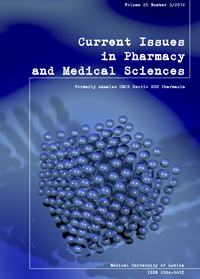Effect of tubulex swabs on post-extraction wound healing
DOI:
https://doi.org/10.12923/j.2084-980X/25.3/a.07Słowa kluczowe:
oral antiseptics, Tubulicid Blue, Tubulex, alveolar healingAbstrakt
Socket healing after tooth extraction is a multistage process, often complicated by pain and inflammatory complications. To prevent complications in healing, many preparations of disinfecting, soothing and supporting the healing process activity are used. The effect of Tubulex swabs on wound healing was evaluated. Tubulex are sterile swabs, moistened with Tubulicid Blue, which contains benzalkonium chloride, amphoteric-2, disodium edetate dehydrate and phosphate buffer saline, giving it disinfectant and soothing properties. A positive effect of the use of Tubulex on the healing of post-extraction wounds has been proved.
Bibliografia
1. Bloomer C. R.: Alveolar osteitis prevention by immediate placement of medicated packing. Oral Surg. 9, 282, 2000.
2. Bonine F. L.: Effect of chlorhexidine rinse on the incidence of dry socked in impacted mandibular third molar extraction sites. Oral Surg. 79, 154, 1995.
3. Chiapasco M., Crescentini M., Romanoni G.: Germectomy or delayed removal of mandibular impacted third molars: the relationship between age and incidence of complications. J. Oral Maxillofac. Surg. 53, 418, 1995.
4. Fetkowska-Mielnik K., Szymańska J.: Ocena kliniczna preparatu Tubulitec. Ogólnopolskie Sympozium Naukowo-Szkoleniowe: 51-54, 1990.
5. Gunsolley J. C.: Clinical efficacy of antimicrobial mouthrinses. J. Dent. 38, 2010, Suppl 1: S6-10.
6. Hammad H., Hammad M., Abdelhadi I., Khalifeh M.: Effects of topically applied agents on intra-oral wound healing in a rat model: a clinical and histomorphometric study. Int. J. Dent. Hyg. 9, 9, 2011.
7. Jańczuk Z., Samochowiec L., Wójcicki J.: Kompendium farmakoterapii dla stomatologów. publ. II Urban & Partner, Wrocław 2002.
8. Karabit M. S.: Studies on the evaluation of preservative efficacy III. The determination of antimicrobial characteristics of benzalkonium chloride. Int. J. Pharm. 46, 141, 1988.
9. Lockhart P. B.: The risk of endocarditis in dental practice. Periodontology 23, 127, 2000.
10. Myśliwiec L. et al.: Czynniki ryzyka podczas usuwania zębów trzecich trzonowych żuchwy. Mag. Stom. 17, 70, 2007.
11. Peterson L. J. et al.: Contemporary Oral and Maxillofacial Surgery. Mosby; 4th edition 2002.
12. Sharvelle S., Skvarenina E., Banks M. K.: Biodegradation of disodium cocoamphodiacetate by a wastewater microbial consortium. Water Environ. Res. 80, 276, 2008.
13. Schuster G.S.: Oral flora and pathogenic organisms. Infect. Dis. Clin. North Am. 13, 757, 1990.
14. Szyszkowska A. et al.: Wpływ Eluspray na gojenie ran poekstrakcyjnych po usunięciu zębów mądrości. Por. Stom. 11, 385, 2010.
15. Szyszkowska A. et al..: Zastosowanie miejscowe preparatu Dentosept po ekstrakcji zęba. Mag. Stom. 12, 100, 2009.
16. Watt S. R., Clarke A. J.: Role of autolysins in the EDTA-induced lysis of Pseudomonas aeruginosa. FEMS Microbiol. Lett. 124, 113, 1994.
17. Wiśniewska I. et al.: Wpływ aplikowania do zębodołu linkomycyny na nośniku TCP na proces gojenia rany po chirurgicznym usunięciu zęba mądrości. Ann. Acad. Med. Stetin 55, 59, 2009.
18. Zejc A., Gorczyca M.: Chemia Leków publ. I PZWL, Warszawa 2002.
19. Zuchowski J., Kleinrok J.: Korony tymczasowe. Mag. Stom. 3, 28, 2003.
20. Żuchowska L., Żuchowski J.: Biologiczne leczenie miazgi i ozębnej zębów stałych. Podsumowanie. TPS 10, 26, 2005.
Pobrania
Opublikowane
Numer
Dział
Licencja
Prawa autorskie (c) 2012 Autorzy

Praca jest udostępniana na licencji Creative Commons Attribution-NonCommercial-NoDerivatives 3.0 Unported License.


